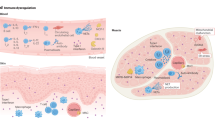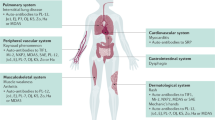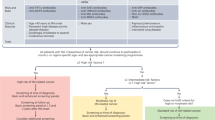Abstract
Idiopathic inflammatory myopathies, known collectively as myositis, are chronic diseases that cause disability, mainly from muscle weakness, despite the use of immunosuppressive therapies. An improved outcome requires increased knowledge of the key molecular pathways that cause symptoms in muscles and other organs. Technological advances offer promise for improving our understanding of disease mechanisms, and some tools will be helpful in diagnosis and the assessment of therapeutic success. The application of new tools depends on their validation in longitudinal studies using clinical outcome measures combined with assessments of molecular events in affected organs. Clinical outcome measures and definitions of improvement have been developed and validated through the International Myositis Assessment and Clinical Studies collaboration. Some imaging techniques, such as MRI and magnetic resonance spectroscopy of muscles, and high-resolution CT of lungs, can assess changes in local inflammatory activity, among many other aspects of pathology. Changes in protein and gene expression patterns in repeated biopsies from affected organs (muscle, skin and lungs) provide molecular information and allow increasingly precise disease classifications and therapeutic evaluation, but are to date only research tools. This Review focuses on advances in diagnostic and outcome tools and their roles in clinical practice and clinical research in patients with polymyositis and dermatomyositis.
Key Points
-
A consensus has been reached within an international multidisciplinary collaborative network, the International Myositis Assessment and Clinical Studies collaboration (IMACS), to use a three-component clinical outcome measure in clinical trials with patients with polymyositis or dermatomyositis
-
A definition of improvement according to the myositis disease activity core set has been proposed, which should facilitate clinical trials
-
Myositis-specific autoantibodies are helpful in diagnosis and in identifying subsets of myositis
-
Imaging, including MRI or magnetic resonance spectroscopy, is a noninvasive technique for use as a diagnostic tool and an outcome measure that is available in many centres and useful in clinical practice
-
Muscle biopsy is a cornerstone for diagnosis and might also be a useful tool to assess molecular effects of interventions, but is so far limited to research projects
-
Gene expression analysis, combined with protein analysis, in muscle biopsy samples is a promising new technique for diagnostic evaluation by identifying patterns of molecular pathways, but requires validation and development and is limited to research
This is a preview of subscription content, access via your institution
Access options
Subscribe to this journal
Receive 12 print issues and online access
$209.00 per year
only $17.42 per issue
Buy this article
- Purchase on Springer Link
- Instant access to full article PDF
Prices may be subject to local taxes which are calculated during checkout


Similar content being viewed by others
References
Arahata K and Engel AG (1984) Monoclonal antibody analysis of mononuclear cells in myopathies. I: Quantitation of subsets according to diagnosis and sites of accumulation and demonstration and counts of muscle fibers invaded by T cells. Ann Neurol 16: 193–208
Plotz PH et al. (1995) NIH conference. Myositis: immunologic contributions to understanding cause, pathogenesis, and therapy. Ann Intern Med 122: 715–724
Engel AG and Arahata K (1986) Mononuclear cells in myopathies: quantitation of functionally distinct subsets, recognition of antigen-specific cell-mediated cytotoxicity in some diseases, and implications for the pathogenesis of the different inflammatory myopathies. Hum Pathol 17: 704–721
Dalakas MC (1991) Polymyositis, dermatomyositis and inclusion-body myositis. N Engl J Med 325: 1487–1498
Dalakas MC and Hohlfeld R (2003) Polymyositis and dermatomyositis. Lancet 362: 971–982
Love L et al. (1991) A new approach to the classification of idiopathic inflammatory myopathy: myositis-specific autoantibodies define useful homogeneous patient groups. Medicine 70: 360–374
Miller FW (1993) Myositis-specific autoantibodies. Touchstones for understanding the inflammatory myopathies. JAMA 270: 1846–1849
Brouwer R et al. (2001) Autoantibody profiles in the sera of European patients with myositis. Ann Rheum Dis 60: 116–123
Timmons AJ et al. (2005) Human muscle gene expression responses to endurance training provide a novel perspective on Duchenne muscular dystrophy. FASEB J 19: 750–760
Hoffman EP et al. (2003) New molecular research technologies in the study of muscle disease. Curr Opin Rheumatol 15: 698–707
World Health Organization (2001) The International classifications of functioning, disability and health. Geneva: World Health Organization
Miller FW et al. (2001) Proposed preliminary core set measures for disease outcome assessment in adult and juvenile idiopathic inflammatory myopathies. Rheumatology (Oxford) 40: 1262–1273
IMACS website [https://dir-apps.niehs.nih.gov/imacs/index.cfm?action=home.main]
Isenberg DA et al. (2004) International Myositis and Clinical Studies Group (IMACS) International consensus outcome measures for patients with idiopathic inflammatory myopathies. Development and initial validation of myositis activity and damage indices in patients with adult onset disease. Rheumatology (Oxford) 43: 49–54
Rider LG et al. (2004) International consensus on preliminary definitions of improvement in adult and juvenile myositis. Arthritis Rheum 50: 2281–2290
Ware JE and Sherbourne CD (1992) The MOS 36-item short-form health survey: conceptual framework and item selection. Med Care 30: 473–483
Alexanderson et al. (1999) Safety of a home exercise programme in patients with polymyositis and dermatomyositis. A pilot study. Rheumatology (Oxford) 29: 608–611
Alexanderson et al. (2000) The safety of a resistive home exercise program in patients with recent onset active polymyositis or dermatomyositis. Scand J Rheumatol 29: 295–301
Cherin P et al. (2002) Results and long-term followup of intravenous immunoglobulin infusions in chronic, refractory polymyositis. Arthritis Rheum 46: 467–474
Danieli MG et al. (2002) Cyclosporin A and intravenous immunoglobulin treatment in polymyositis/dermatomyositis. Ann Rheum Dis 61: 37–41
Badrising UA et al. (2002) Comparison of weakness progression in inclusion body myositis during treatment with methotrexate or placebo. Ann Neurol 51: 369–372
Dalakas MC et al. (2001) A controlled study of intravenous immunoglobulin combined with prednisone in treatment of IBM. Neurology 56: 323–327
van der Meulen MFG et al. (2000) Oral pulsed high-dose dexamethasone for myositis. J Neurol 247: 102–105
Walter MC et al. (2000) High-dose immunoglobulin therapy in sporadic inclusion body myositis: a double-blind, placebo-controlled study. J Neurol 247: 22–28
Hengstman GJ et al. (2003) Successful treatment of dermatomyositis and polymyositis with anti-tumor-necrosis-factor-alpha: preliminary results. Eur Neurol 50: 10–15
Spector SA et al. (1997) Safety and efficacy of strength training in patients with sporadic inclusion body myositis. Muscle Nerve 10: 1242–1248
Wiesinger GF et al. (1998) Improvement of physical fitness and muscle strength in polymyositis/dermatomyositis patients by a training programme. Br J Rheumatol 37: 196–200
Wiesinger GF et al. (1998) Benefit of 6 months long-term physical training in polymyositis/dermatomyositis patients. Br J Rheumatol 37: 1338–1342
Alexanderson H et al. (2006) Patients with chronic inflammatory myopathies have reduced muscle endurance rather than reduced muscle strength [abstract]. Arthritis Rheum 54 (Suppl): 1639: S658
Josefson A et al. (1996) A functional index in myositis. J Rheumatol 23: 1380–1384
Vencovsky J et al. (2000) Cyclosporine A versus methotrexate in treatment of polymyositis and dermatomyositis. Scand J Rheumatol 29: 95–102
Heikkilä S et al. (2001) Rehabilitation in myositis. Physiotherapy 87: 301–309
Alexanderson H et al. (2006) Functional index-2: validity and reliability of a disease-specific measure of impairment in patients with polymyositis and dermatomyositis. Arthritis Rheum 55: 114–122
Newcomer KL et al. (1993) Validity and reliability of the timed-stands test for patients with rheumatoid arthritis and other chronic diseases. J Rheumatol 20: 21–27
Agarwal S et al. (2006) Two simple, reliable and valid tests of proximal muscle function, and their application to the management of idiopathic inflammatory myositis. Rheumatology (Oxford) 45: 874–879
Marie I et al. (2002) Interstitial lung disease in polymyositis and dermatomyositis. Arthritis Rheum 47: 614–622
Fathi M et al. (2004) Interstitial lung disease, a common manifestation of newly diagnosed polymyositis and dermatomyositis. Ann Rheum Dis 63: 297–301
Mayberry JP et al. (2000) Thoracic manifestations of systemic autoimmune diseases: radiographic and high-resolution CT findings. Radiographics 20: 1623–1635
Wilkes MR et al. (2005) Treatment of antisynthetase-associated interstitial lung disease with tacrolimus. Arthritis Rheum 52: 2439–2346
Barthel DW and Mahoney FI (1965) Functional evaluation; the Barthel Index. Md State Med J 14: 61–65
Varju C et al. (2003) The effect of physical exercise following acute disease exacerbation in patients with dermato/polymyositis. Clin Rehabil 17: 83–87
Alexanderson H et al. (2002) Development of the myositis activities profile—validity and reliability of a self-administered questionnaire to assess activity limitations in patients with polymyositis/dermatomyositis. J Rheumatol 29: 2386–2392
Alexanderson H et al.: Safety and benefits of an intensive resistive exercise program in patients with stable, inactive polymyositis or dermatomyositis. Arthritis Rheum, in press
Henriksson KG (1979) 'Semi-open' muscle biopsy technique. A simple outpatient procedure. Acta Neurol Scand 59: 317–323
Dorph C et al. (2001) Percutaneous conchotome muscle biopsy. A useful diagnostic and assessment tool. J Rheumatol 28: 1591–1599
Lundberg I et al. (2000) Decreased expression of interleukin-1a lpha-beta and cell adhesion molecules in muscle tissue following corticosteroid treatment in polymyositis and dermatomyositis. Arthritis Rheum 43: 336–348
Ulfgren AK et al. (2004) Down-regulation of the abberant expression of the inflammation mediator High Mobility Group Box Chromosomal Protein 1 in muscle tissue of patients with polymyositis and dermatomyositis treated with corticosteroids. Arthritis Rheum 50: 1586–1594
Nyberg P et al. (2000) Increased expression of interleukin 1alpha and MHC class I in muscle tissue of patients with chronic, inactive polymyositis and dermatomyositis. J Rheumatol 27: 940–948
Dalakas MC (1996) Clinical benefits and immunopathological correlates of intravenous immune globulin in the treatment of inflammatory myopathies. Clin Exp Immunol 104 (Suppl 1): 55–60
Nagaraju K et al. (2005) Activation of the endoplasmic reticulum stress response in autoimmune myositis: potential role in muscle fiber damage and dysfunction. Arthritis Rheum 52: 1824–1835
Greenberg S et al. (2005) Interferon-alpha/beta-mediated innate immune mechanisms in dermatomyositis. Ann Neurol 57: 664–678
Tezak Z et al. (2002) Gene expression profiling in DQA1*0501+ children with untreated dermatomyositis: a novel model of pathogenesis. J Immunol 168: 4154–4163
Raju R et al. (2005) Gene expression profile in the muscles of patients with inflammatory myopathies: effect of therapy with IVIg and biological validation of clinically relevant genes. Brain 128: 1887–1896
Hofbauer M et al. (2003) Clonal tracking of autoaggressive T cells in polymyositis by combining laser microdissection, single-cell PCR, and CDR3-spectratype analysis. Proc Natl Acad Sci USA 100: 4090–4095
Greenberg S et al. (2005) Plasma cells in muscle in inclusion body myositis and polymyositis. Neurology 65: 1782–1787
Englund P et al. (2002) Interleukin-1alpha expression in capillaries and major histocompatibility complex class I expression in type II muscle fibers from polymyositis and dermatomyositis patients: important pathogenic features independent of inflammatory cell clusters in muscle tissue. Arthritis Rheum 46: 1044–1455
van der Pas J et al. (2004) Diagnostic value of MHC class I staining in idiopathic inflammatory myopathies. J Neurol Neurosurg Psychiatry 75: 136–139
Civatte M et al. (2003) Class I MHC detection as a diagnostic tool in noninformative muscle biopsies of patients suffering from dermatomyositis (DM). Neuropathol Appl Neurobiol 29: 546–552
Dorph C et al. (2006) Patient reported symptomatic muscle weakness is independent of inflammation in muscle tissue from patients with polymyositis and dermatomyositis. Ann Rheum Dis 65: 1565–1571
Park JH et al. (1998) Analysis of 31P MR spectroscopy data using artificial neural networks for longitudinal evaluation of muscle diseases: dermatomyositis. NMR Biomed 11: 245–256
Miller FW et al. (1990) Origin and regulation of a disease-specific autoantibody response. Antigenic epitopes, spectrotype stability, and isotype restriction of anti-Jo-1 autoantibodies. J Clin Invest 85: 468–475
Acknowledgements
We thank Professor L Klareskog for his critical review of the manuscript and Associate Professor R van Vollenhoven for his valuable comments on the manuscript and for linguistic advice.
Author information
Authors and Affiliations
Corresponding author
Ethics declarations
Competing interests
I.E.L. states the following conflict of interest disclosures: that she is the recipient of an unrestricted research grant from Schering–Plough Nordic Biotech for $20,000 and an unrestricted research grant from Roche for $20,000. H Alexanderson declared she has no competing interests.
Rights and permissions
About this article
Cite this article
Lundberg, I., Alexanderson, H. Technology Insight: tools for research, diagnosis and clinical assessment of treatment in idiopathic inflammatory myopathies. Nat Rev Rheumatol 3, 282–290 (2007). https://doi.org/10.1038/ncprheum0479
Received:
Accepted:
Issue Date:
DOI: https://doi.org/10.1038/ncprheum0479



